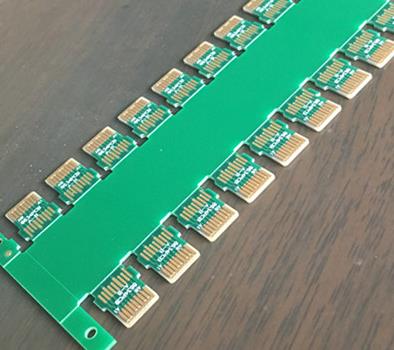One, PCB board concept
PCB is the abbreviation of Printed Circuit Board. The Chinese name is printed circuit board, also known as printed circuit board and printed circuit board. It is an important electronic component, a support for electronic components, and a provider of electrical connections for electronic components. Because it is made by electronic printing, it is called a "printed" circuit board.
Second, the history of PCB
The inventor of the printed circuit board was Paul Eisler, an Austrian, who used the printed circuit board in a radio device in 1936. In 1943, the Americans used this technology extensively in military radios. In 1948, the United States officially recognized such an invention for commercial use. Since the mid-1950s, printed circuit board technology has only begun to be widely adopted. Before the printed circuit board was displayed, the interconnection between electronic components was realized by direct connection of wires. At present, circuit breadboards exist as effective experimental tools; printed circuit boards have just occupied an absolute dominant position in the electronics industry. PCB design The design of the printed circuit board is based on the circuit principle picture to realize the functions required by the circuit designer.

The design of the printed circuit board mainly refers to the design of the plate picture, which needs to consider various factors such as the layout of external connections, the optimized layout of the internal electronic components, the optimized layout of metal connections and through holes, electromagnetic protection, and heat dissipation. Excellent version of the picture design can save production costs and achieve good circuit performance and heat dissipation performance. Easy plate picture design can be realized by hand, and complex plate picture design needs to be realized with the help of computer-aided design (CAD). Classification of PCB According to the number of circuit layers, it is divided into single-sided, double-sided and multi-layer boards. Common multi-layer boards are generally 4-layer boards or 6-layer boards, and complex multi-layer boards can reach more than a dozen layers.
Three, PCB circuit board classification
Classification according to the number of circuit layers: divided into single-sided, double-sided and multi-layer boards. Common multi-layer boards are generally 4-layer boards or 6-layer boards, and complex multi-layer boards can reach dozens of layers.
Single-Sided Boards On the most basic PCB circuit boards, the parts are concentrated on one side, and the wires are concentrated on the other side (when there are SMD components and the wires are on the same side, the plug-in devices are on the other side). Because the wires only appear on one side, this kind of PCB circuit board is called a single-sided (Single-sided). Because single-sided boards have many strict restrictions on the design of the circuit (because there is only one side, the wiring cannot cross and must be around a separate path), so only early circuits use this type of board.
Double-Sided Boards This kind of PCB board has wiring on both sides, but to use wires on both sides, there must be a proper circuit connection between the two sides. The "bridge" between such circuits is called a via. A via is a small hole filled or coated with metal on the PCB board, which can be connected with the wires on both sides. Because the area of the double-sided board is twice as large as that of the single-sided board, the double-sided board solves the difficulty of interlacing wiring in the single-sided board (it can be conducted to the other side through holes), and it is more suitable for use in circuits that are more complicated than the single-sided board.
Multi-Layer Boards In order to increase the area that can be wired, multi-layer boards use more single or double-sided wiring boards. Use one double-sided as the inner layer, two single-sided as the outer layer, or two double-sided as the inner layer and two single-sided as the outer layer of the printed circuit board. The positioning system and the insulating bonding material alternately together and the conductive pattern Printed circuit boards that are interconnected according to design requirements become four-layer and six-layer printed circuit boards, also known as multilayer printed circuit boards. The number of layers of the board does not mean that there are several independent wiring layers. In special cases, empty layers are added to control the thickness of the board. Usually, the number of layers is even and includes the two outermost layers. Most of the motherboards have 4 to 8 layers of structure, but technically, it is possible to achieve nearly 100 layers of PCB boards. Most large supercomputers use fairly multi-layered motherboards, but because these types of computers can already be replaced by clusters of many ordinary computers, super-multilayered boards have gradually ceased to be used. Because the layers in the PCB board are tightly integrated, it is generally not easy to see the actual number, but if you look closely at the motherboard, you can still see it.
Fourth, the status quo of the PCB industry
Since the manufacture of printed circuit boards is in the latter half of the manufacture of electronic equipment, it has become a downstream industry of the electronics industry. Almost all electronic devices need the support of printed circuit boards, so printed circuit boards are the product with the highest market share in the global electronic component products. At present, Japan, China (including Taiwan), Western Europe and the United States are the most important printed circuit board manufacturing bases.
Five, PCB Allegro
Fast means fast delivery! The Allegro factory is different from the batch factory. The Allegro factory is mainly based on a new type of PCB factory model with proofing and small and medium-sized batches. It can achieve single-sided and double-sided shipments in as fast as 8 hours, and 4-layer boards as fast as 48 hours. For shipment, the advantage of making PCB Allegro is that the result of trial production of a product is very fast. In short, the meaning of PCB Allegro is that the delivery time is fast and stable.